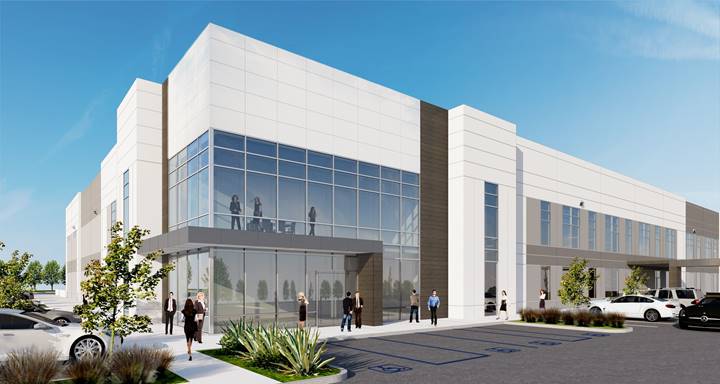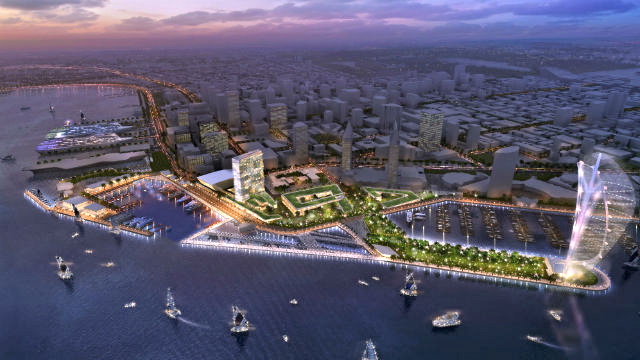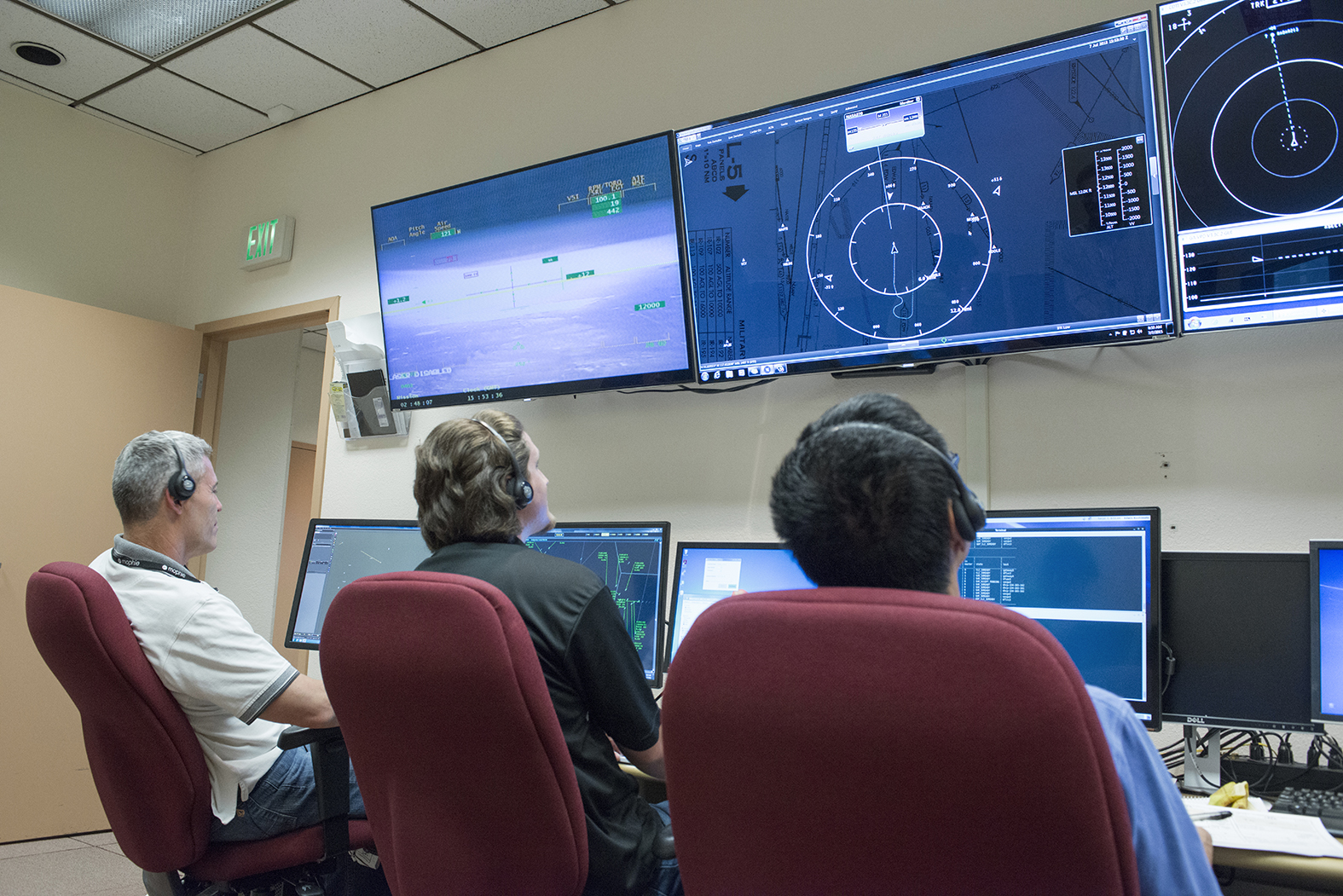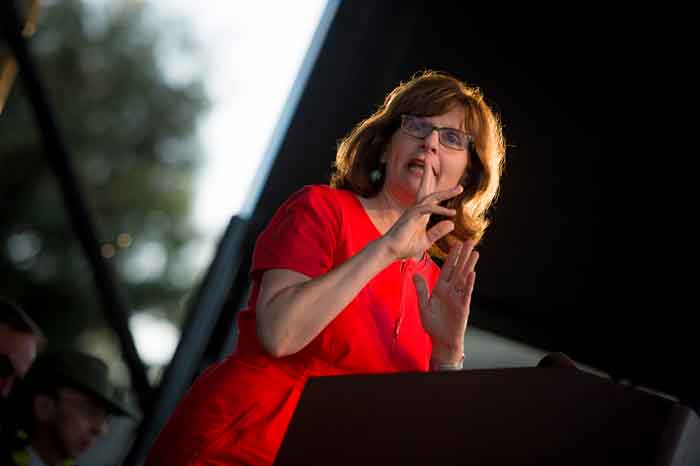Daily Business Report-July 11, 2016
A rendering of the plan for the north and south Embarcadero proposed by Manchester Financial Group.
Manchester Group Offers Plan
For Downtown Central Embarcadero
Times of San Diego
Manchester Financial Group announced details Friday of its proposal to the Port of San Diego to transform the Central Embarcadero with new parks, restaurants, an aquarium and a 400-foot sculpture and lookout called the Spinnaker.
The well-known San Diego developer’s Celebration Place proposal includes a 500-room boutique hotel, 2,500-seat performance hall, 250,000 square feet of shopping and dining, an aquarium, commercial fishing and 2,600 parking spaces.
Located on the southern tip would be the 400-foot Spinnaker, a transparent sail constructed of LED fibers, with a viewing area at the top.
“Our vision for Celebration Place is to create a world-class waterfront with multiple parks and activities, a unique baywalk, a bustling commercial harbor, a new icon for San Diego, and a public realm that’s all about honoring the water,” said Doug Manchester, chairman of the development firm.
“We believe this is the most important site in San Diego, and our enduring goal will be to beautify the bay front for residents and visitors, ultimately giving the land back to the community as a gift to the people of this region,” he said.
The Manchester proposal is one of six for the 70-acre site, which includes Embarcadero Marina Park North, Ruocco Park and Tuna Harbor, as well as Seaport Village. The port’s board of commissioners will hold a public workshop on Wednesday to hear the proposals.
_________________________________
Wednesday’s Workshop
The Board of Port Commissioners workshop will be held at 10 a.m. in the Indigo Ballroom at the Hilton San Diego Bayfront, 1 Park Blvd. Downtown. Validated parking will be available for the parking garage adjacent to the hotel.
_________________________________
Another San Diego developer, Olicwe McMillan, offered plans for the Embarcadero District, which would include a world-class event venue, a variety of hospitality options, stores and restaurants, a public marketplace, an indoor/outdoor ecological learning center, a performance space for public benefit, and a marina.
Manchester is developer of the Manchester Grand Hyatt, the San Diego Marriott Marquis and Marina and the Manchester Pacific Gateway project.
All six proposals are now available online.
____________________________________________
TAKING A BREATHER
THE DAILY BUSINESS REPORT WILL NOT BE POSTED THE REST OF THIS WEEK.
LOOK FOR ITS RETURN NEXT WEEK.
Manny Cruz, editor
____________________________________________

RAF Pacifica Group to Build Big
Industrial/R&D Center in Carlsbad
RAF Pacifica Group has acquired 13.2 acres of land in the Carlsbad Oaks North Corporate Center where the firm plans to build an industrial/R&D facility totaling 168,000 square feet.
The firm’s planned development project, which will be known as “vec•tor,” is planned as a two-story facility that will accommodate one or two industrial or research tenants, according to Adam Robinson, principal of RAF Pacifica Group. The industrial center will include ample parking, grade-level and dock-high loading doors, and a glass-centric design to ensure natural lighting for users.
vec·tor will be situated in Carlsbad Oaks North, a 120-acre master planned corporate business park in Carlsbad where leading biopharmaceutical company IONIS Pharmaceuticals is headquartered, and other major biotech companies are located.
RAF Pacifica Group acquired the 13.2-acre land parcel for $8.86 million from Kilroy Realty. The development site is located at the intersection of Whiptail Loop and Faraday Avenue. Mike Erwin and Tucker Hohenstein of Colliers International represented RAF Pacifica Group as the buyer in the transaction.
SANDAG Board OKs $18 Billion
Measure for November Ballot
The SANDAG Board of Directors voted Friday to place a countywide measure on the November 2016 ballot to raise $18 billion to repair roads, relieve highway congestion, improve transit and bike/pedestrian networks, conserve open space, and manage land to reduce wildfire risk.
The measure is the “San Diego County Road Repair, Transit, Traffic Relief, Safety and Water Quality Measure.”
“What we approved today will benefit not just this generation but our children and our grandchildren,” said SANDAG Chair and County Board of Supervisors Chair Ron Roberts. “If we are going to prosper as a region and maintain our quality of life, we need to invest in our infrastructure, our mobility, and our environment with a dedicated source of local revenue – money that Sacramento can’t take away.”
If approved by two thirds of the voters in the region, the measure would increase the sales tax by half a penny over the next 40 years.
For more information, click here.
Chargers to Present Updated Stadium Plans
Family Health Centers of San Diego is inviting the public to hear a report on the San Diego Chargers’ Downtown stadium project on Friday, but is charging $25 for admission to the presentation.
The event is scheduled for 11:30 a.m. at the Logan Heights Family Health Center, 1809 National Ave., San Diego.
John Spanos, president of Football Operations, and representatives from the San Diego Chargers, including Special Advisors Fred Maas and Jeffrey Pollack, will speak about the stadium initiative. They are expected to present new stadium renderings, provide updates on the project and field questions from the audience.
Tickets are available for purchase at www.fhcsd.org/spirit-of-the-barrio.
San Diego County Home Sales Slowed
By City News Service
The number of homes that changed hands in the San Diego region last month continued to fall in most categories amid tight inventory, statistics released Friday show.
Just over 2,200 single-family residences sold in June, 14 percent lower than May and 4 percent fewer than the same month last year, the San Diego Association of Realtors reported. For attached homes like condominiums and townhomes, 1,215 changed ownership last month. That’s 3 percent above May but 6 percent below June 2015.
SDAR data shows that prices mostly rose, but not by much.
The median price of a house sold in June was $567,500, which is $250 above May’s figure 4 percent over the same month last year.
For condos, the median sales price was $380,000, 1 percent higher than a month prior and 9 percent over one year ago.
“Halfway through 2016, the residential real estate market is performing well, despite the limited number of homes for sale,” said SDAR President Cory Shepard. “Buyers who are in the market still have the benefit of wonderfully low interest rates.”
Residential properties are staying on the market for less than a month, averaging 29 days in June, according to SDAR. The supply of resale homes is languishing at 2.3 months, about half of a healthy supply.
The most expensive home sold last month was a 14-bedroom, 19-bath, 14,000-square-foot Coronado estate, circa 1926, that went for $13.3 million.
Council to Mull a Tax on Marijuana
And Other Ballot Measure Proposals
By City News Service
From taxing marijuana to raising money for firehouse construction, various proposals for November ballot measures in San Diego will be vetted for the first time by the San Diego City Council today.
The council members will decide whether to have the City Attorney conduct legal analysis and draft ballot language on the suggestions. Final decisions on whether to actually place the proposals on the general election ballot would come later.
Those that eventually go before voters would be in addition to 17 state propositions, plus maybe one on a stadium for the Chargers and another that would impact the future of tourism and set aside the Qualcomm Stadium site for educational and park use. The San Diego Association of Governments will also ask voters to increase the sales tax by a half-cent to pay for infrastructure projects.
Councilman Mark Kersey suggested imposing an 8 percent tax on gross receipts on businesses that sell marijuana, should state voters pass a recreational use legalization proposition this fall. He said at a committee meeting last month that cannabis sold for medical purposes would not be taxed under his plan.
Approval of the state proposition would create an unfunded mandate that would financially burden city government, according to the councilman.
“I do not want to divert money away from street repair or further stretch our public safety resources in order to manage an unorthodox legal framework that will be imposed on our city in November when it passes,” Kersey said.
The firehouse bond measure was proposed by Councilwoman Marti Emerald, who said it would generate $205 million to construct around 20 stations that were called for in a consultant’s report.
Emerald said the average homeowner would pay $5 for every $100,000 in assessed value. That’s around $25 a year, she said at a meeting in April, calling it “a real value for greater public safety going forward.”
She said the city is building a fire station every five years. At that rate, it would take nearly a century to complete the number currently needed. Funding from her bond measure would instead allow the stations to be built in a decade.
Other measures that the council members will consider would amend the City Charter to:
• Establish procedures for removing a wayward elected official from office, which were not available when scandal-plagued Bob Filner was mayor three years ago.
• List City Attorney qualifications and responsibilities.
• Extend a section on use of Mission Bay leasehold revenue for 30 years and increase the portion that can be spent on upgrading other regional parks.
• Require all ballot measures to go before voters in November general elections.
• Mandate that all races for city offices have a runoff in November, no matter whether the top vote-getter receives over 50 percent.
Supporters of the latter two said their proposal would have races and ballot measures decided by larger numbers of voters, since more people go to the polls in the fall than during primary elections.
Another ballot measure that will be considered would require public disclosure of city business conducted by employees on their personal electronic devices.
Two other measures that could go before voters this fall are already being drafted by the City Attorney’s Office. One would determine whether to let San Diego High School stay on Balboa Park land or have the property return to park use, and the other would introduce reforms to the Citizen’s Review Board on Police Practices.
Downtown Chargers Stadium Gets
Enough Signatures for November Vote
By City News Service
The Chargers have submitted enough signatures in support of the downtown stadium and convention center annex plan to qualify it for the November ballot, the City Clerk’s Office announced Saturday.
“The petition has been verified and found sufficient in signatures to qualify the ordinance to be submitted to the city council for adoption, or for rejection and submission to the electorate,” City Clerk Elizabeth Maland wrote in a memo to the mayor and city council.
The “San Diego Integrated Convention Center Expansion/Stadium and Tourism Initiative,” as it is formally known, received almost 79,000 projected valid signatures from supporters, according to figures released by the San Diego County Registrar of Voters. t
The initiative required 66,447 valid signatures to qualify for the November ballot. The Chargers submitted 110,380 signatures that were collected over a six-week period for consideration. A random sampling of three percent of the signatures indicated there were more than enough, according to the clerk’s memo.
The plan calls for a 61,500-seat facility in the East Village. If it’s passed by voters in November, the project would raise the necessary funds by increasing the hotel room tax to 16.5 percent, while the Chargers would chip-in $350 million and use a $300 million loan from the National Football League.
The hotel room tax in San Diego is 10.5 percent, plus a 2 percent fee used for tourism promotions, so the hike would effectively be four percentage points.
Voter approval of the plan is required due to the tax increase, but because of a recent court ruling, it’s unclear if a simple or two-thirds majority will be required in November. Chargers officials said they will aim for two-thirds to be on the safe side.
Many city elected officials have come out against the Chargers plan because of its use of public funds.
The Chargers have been asking for a Qualcomm Stadium replacement for more than 15 years. In January, NFL owners rejected their plans to build a playing facility in Carson jointly with the Oakland Raiders, after which owner Dean Spanos announced he would give San Diego another try.
If the San Diego effort falls through, Spanos said he has an agreement in place to have the Chargers become the second team in a future Inglewood stadium with the Los Angeles Rams.




